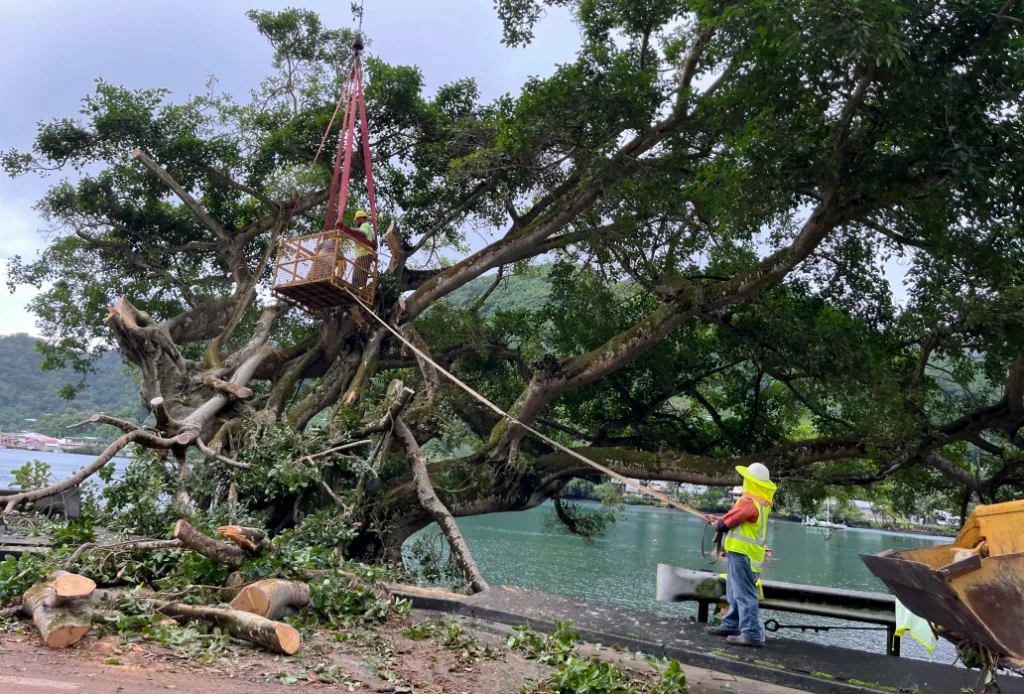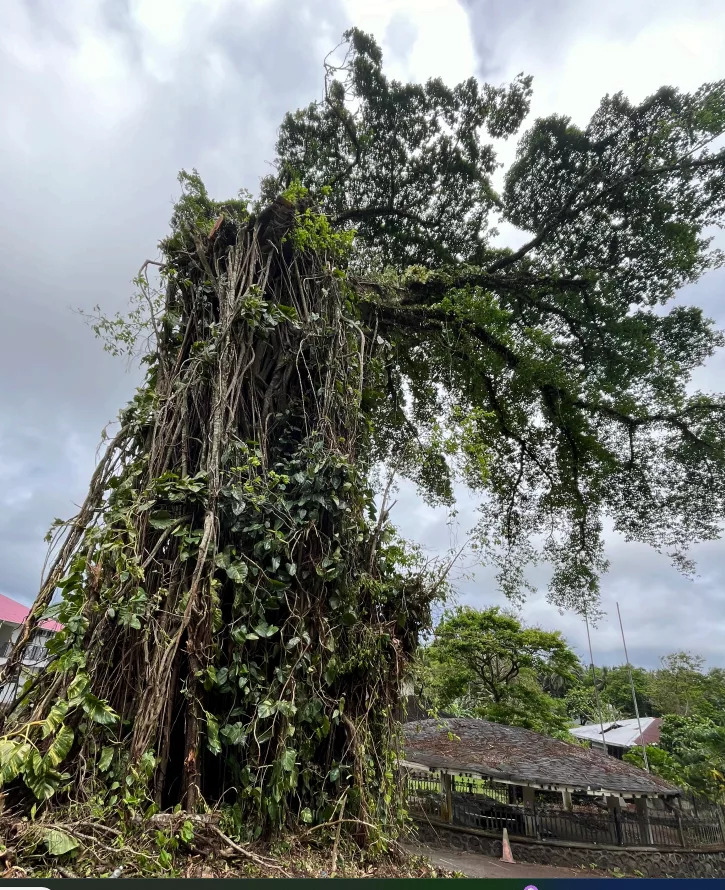
Dear Editor,
I enjoy the drive along the main road of our beautiful American Samoa, which stretches from one end of the island to the other. Although the splendor is pleasing to the eyes and soul, I am also struck with sadness, specifically by the sight of many old trees that have been cut down. The reasons for removing these trees often seem unclear or senseless.
In February 2024, my husband Rudy and I were driving from the west side heading east. A typical ki’eki’e ka’avale day with his mother Senouefa, aka Maligitoa, to enjoy the island and to visit Leloaloa, where her mother’s family is from. Along the way, on this particular day, we observed men in green-fluorescent construction vests, a crane, and other heavy equipment near a large pulu tree by the seashore, just before the Satala power plant. They were cutting down a massive pulu tree.
My mother-in-law who is 82-years-old was visually distraught and saddened by the ordeal of terminating the old tree, a piece of history. She recalled fond memories of this pulu tree. As children in Leloaloa, she walked with her siblings, cousins, and friends to the movies in Pago Pago, and along the way they would rest and play at this pulu tree. She remembered back then that the pulu tree was large and mature. Simple math and deductive reasoning would inform us that this pulu tree was at least 100 years old, before its demise earlier this year.
A resident that lives near where the pulu tree once stood shared frustration, explaining that their family and neighbors were not aware and were not informed about the tree’s removal. The families that live near this area watched many fautasi races through the years under this pulu tree, in the comfort of the shade it provided, and its protection from passing traffic.
Not clear why the tree was removed, but sidewalk damaged due to the tree roots was mentioned. A weak and careless justification. There are construction solutions for the sidewalk that does not involve tree removal, solutions that require creativity and care. In addition to the shade that these trees provide; they also stabilize the land, preventing erosion with their roots. In fact, planting more trees along our shores would help mitigate the erosion that threatens our island.
In July 2024, while driving home from work on the main road we noticed another large pulu tree that had been chopped down across from the road towards Fagaima. This pulu tree brought back memories of my childhood when my family would go for Sunday rides and would stop to enjoy ice cream, and along the way we would encounter these beautiful trees. Almost every village on the island has a pulu tree, and each one has a story associated with it. In the village of Alofau my childhood memories include a massive pulu tree that stands today near the village malae, with graves shaded by its branches and leaves. As children, our elders instructed us to move quietly when walking near this pulu tree at night, lest the ghosts would do us harm.
In August 2024, two mature mango trees were cut down in Nuu’uli across from the A Plus Insurance building. I am not certain why these trees were cut down. I have fond memories of my cousin Utumoe and I climbing mango trees and enjoying their fruits, which could be consumed when ripe or with soy sauce and sugar when not ripe.
On September 23, 2024, I observed ASPA workers trimming and possibly working towards removal of a large āoa tree near the Aveina Store in Nuu’uli. Trees are sometimes trimmed or removed to provide safe clearances from electrical lines. That was not the case here as there are no electrical lines near this āoa tree. ASPA could have been tasked to remove the tree for other reasons.
towards removal of a large āoa tree near the Aveina Store in Nuu’uli. Trees are sometimes trimmed or removed to provide safe clearances from electrical lines. That was not the case here as there are no electrical lines near this āoa tree. ASPA could have been tasked to remove the tree for other reasons.
Remembering the pulu tree in Pago Pago, I became concerned and contacted the Department of Marine and Wildlife Resources (DMWR) to confirm if there were any conservation efforts for these trees, no one answered. That evening, I pondered the fate of the helpless tree with the level of trimming it received, and worse its complete termination.
The Tafuna Plain was once covered in a lush lowland rainforest, characterized by towering indigenous āoa trees (Ficus obliqua and F. prolixa), which played a key role in both the ecosystem and local culture. Today, only a small fragment of this forest called Naumati Lowland Rainforest survives near the Tia Seu Lupe Historical Monument, and even fewer āoa trees remain standing within Naumati and throughout the Tafuna Plain.
They are hard to miss, they are the tallest trees in the Tafuna Plain with aerial roots. These majestic trees provide essential habitats for wildlife, including fruit bats (pe’a) and native birds like the many-colored fruit dove (manuma), which rely on the trees’ berries. However, the significance of these trees extends far beyond providing shelter and food for wildlife—they play a critical role in maintaining the health of the island’s drinking water.
Āoa trees, along with the broader lowland rainforest, function as a natural filtration system for groundwater. Their deep root systems help stabilize the soil and reduce erosion. The roots also help to trap and filter rainwater as it percolates through the ground. As rainwater seeps into the soil, the forest acts as a sponge, absorbing excess water and allowing it to slowly trickle down into underground aquifers—the primary source of drinking water for the island. Beyond their ecological importance, āoa trees have been deeply rooted in Samoan culture for generations.
The āoa trees have medicinal and practical benefits in Samoan life. Traditionally, the wood of these trees has been used for firewood, long hanging aerial roots sometimes used for rough cordage, while the bark and leaves have various medicinal applications. As noted by ethnobotanist Dr. Arthur Whistler, the Samoan people have long used an infusion of the crushed aerial roots to treat inflammation. The leaves of the āoa are used for ailments like boils, urinary tract problems, and stomachaches. The sight of these gentle giants being cut down is heartbreaking, as they are a living link to the past—both natural and cultural. Their continued decline raises concerns that future generations may only know the āoa through pictures and stories, rather than experiencing their majesty and the ecosystem firsthand.
If we continue to remove these historical trees without careful thought, we must ask ourselves: what impact will this have on our environment and our communities? These trees take decades to mature, and their loss cannot be easily undone. We must be stewards of our land as were our ancestors, recognizing the trees as our brothers and sisters, us. They provide so much—food, shelter, clean air, filtered water, recreation, protection from erosion, stories, and more. Before cutting down these marvelous creations of nature, let us urge ourselves to ensure we are doing so for the right reasons.
There is a balance between growth/development and preservation, hence, it is not necessarily one or the other but rather seeking smart solutions to achieve both. If American Samoa does not yet have a tree code ordinance to manage tree-related issues, adopting a tree code or a similar framework from other islands, such as Hawaii, would be a recommendation. Let us act now to protect our natural and cultural heritage for future generations.
Ma le ava tele,
Natasha Tuato’o-Bartley
O se Tama Fanau o Amerika Samoa




